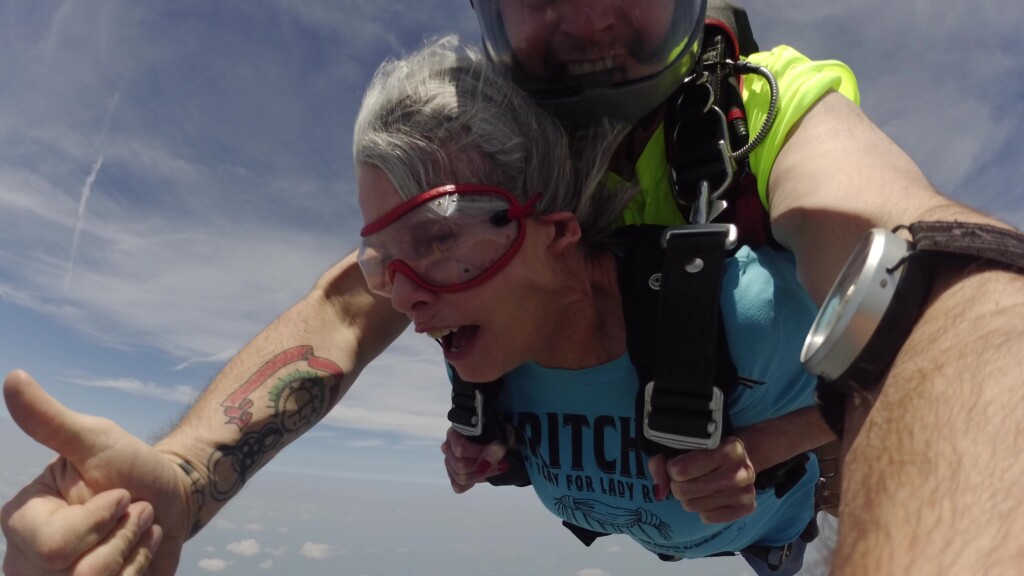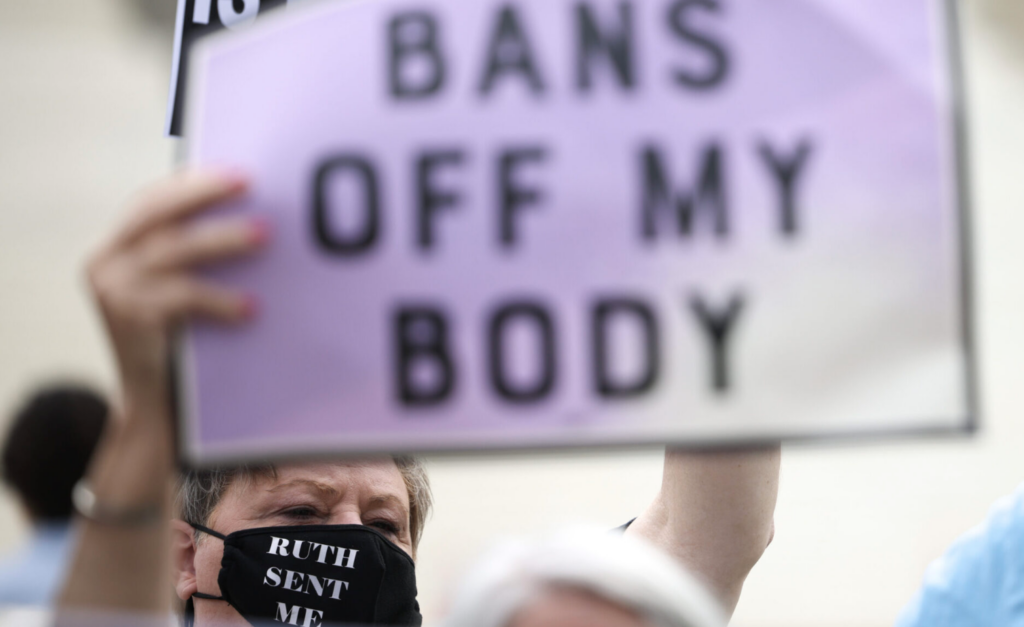Innocence is the Worst Defense: Patty Prewitt’s release and fight for prison reform
On June 2 of 2025, a month before her 76th birthday, Patty Prewitt had her head in the clouds—in an airplane ten thousand feet above ground, strapped with a parachute and a video camera, and eagerly waiting to plummet toward the ground at 120 miles per hour.
Before stepping out into a total freefall, Patty told the skydiving instructor, “If we die, I want you to play the video of my fall at my funeral because funerals are dull, and this’ll liven up the place.”
Patty walks through life with a keen sense of humor and infectious kindness. But six months prior to her triumphant act of hurling herself from a plane, Patty sat within the walls of the Women’s Eastern Reception, Diagnostic and Correctional Center in Vandalia, Missouri, serving out a life sentence for a crime she maintains she did not commit.
In prison, her life was restricted—her movement, her choices, her body, her identity; none of it was hers. But as Patty soared through the clouds after decades of caged existence, she had finally chosen a voluntary risk; a very literal liberation.
For nearly four decades, Patty paid the price for someone else’s mistake. In a trial characterized by sexism and misogyny, she was taken from her five children, but as the decades passed, Patty never let go of the hope of seeing them again as a free woman.
“Every day for all those years, I woke up and I thought ‘This may be the day that I get the phone call. This may be the day that I go home,” Patty says. “That’s pretty stupid, but that kept me going.”
Her hopes were finally answered on December 20. Patty’s oldest daughter, Jane Prewitt Watkins, was visiting her mother like she had done so countless times over the years, only interacting with her through supervised conversations and limited physical touch. Only this time, Patty was going home with her. Imprisoned across the administrations of six different Missouri governors, Mike Parsons finally made a decision long overdue—commuting her sentence.
Frantically, Watkins called everybody she could think of, lighting a bat signal to call the Prewitts home. Siblings, cousins, grandchildren, and all left behind jobs, clients, and responsibilities to welcome Patty home, many of whom had never met her outside of prison walls.
“She has lots of grandkids, but they had never had their grandma home,” Watkins says. “They had seen how hard everybody had worked—they worked. All of our kids have marched around with signs and asked all of their friends to sign petitions and write letters to the governor, and do all of these events their entire lives.”
At Watkins’ home in Greenwood, a guestroom had laid empty for years, always intended for the day Patty would be released.
“No one could understand the relief and happiness that this Christmas had,” Watkins says.
Once Missouri’s longest-serving female prisoner, Patty spent 38 years behind bars for the murder of her husband, Bill, in 1984. Bill was fatally shot in the couple’s Holden home on the night of Feb. 18, 1984. Patty has always said that the attack was carried out by an intruder who raped her and shot Bill. Since her conviction, a chorus grew calling for her release and supporting her claims of innocence.
In 2019, the former director of the Missouri Department of Corrections, George Lombardi, endorsed her release. In his 41 years of employment, he had never done so for any other prisoner.
Naive to the legal system before her incarceration, Patty had denied a plea deal that would have made her eligible for parole after seven years. Thinking justice would prevail, Patty wrongfully placed her trust in a legal system that did not work for her, especially as a woman.
From the very start of the investigation, police immediately focused on Patty as the main suspect. They consistently ignored credible leads pointing to an intruder and failed to collect key evidence that could have identified the individual who assaulted Patty and murdered her husband, including the omission of a mysterious car parked outside of their home on the night of the murder.
“It’s astounding what people won’t let you do to even try and prove your innocence,” Watkins says.
To secure a conviction, the state banked on the testimony of a discredited pathologist who mischaracterized forensic evidence to paint the picture of Patty’s guilt. The prosecution portrayed Patty as a bad mother, mocked her sexual history, and instructed the jurors that the “dignity of the institution of marriage” demanded a conviction.
Despite the injustice of her imprisonment, Patty refused to let her incarceration define her.
“I had children and grandchildren, and I wanted to show them that no matter where you are, you make the best of it,” Patty says.
Patty began writing letters to her friends and family, as it had become a habit that helped to keep her grounded. She would never share with her parents or her kids the bad things that took place in prison, sparing the harsh details, but she would spin them into teaching moments.
“Nobody needs to know bad bad bad stuff,” Patty says. “Nobody needs that negativity. For the kids, sometimes it was like a life lesson.”
For 38 years, Patty wrote letters every day, keeping her tethered to the world outside. But she was also giving a voice to the countless other women locked up beside her.
Her life story and collected letters coalesced into a two-part memoir, Trying to Catch Lightning in a Jar, published by Some People Press, a nonprofit that publishes memoirs and teaches writing classes for incarcerated people. The first volume covers the first 20 years of her sentence, while the second part, which has yet to be released, will include the final 18 years, as well as her “Exit Story”.
“Mom did an amazing job of keeping us informed of what was going on in the prison, but also lifting us up,” Watkins says. “Parts of the book are hard to read because there’s bad shit that happens in prison, and parts of it are a true reflection of how she did a good job of making us feel better.”
Through her letters, Patty also described the lives of the women around her, and she was appalled by the number of women incarcerated for ridiculous sentences for small mistakes. But she also found hope in the stories of women who left prison with nothing and still found their way.
“That’s one reason I wrote this book because I wanted people to know that the women in prison; they’re really good people, but they’ve had terrible disadvantages,” Patty says. “I was shocked at the number of women in prison who had been sexually abused by family members. To hear those stories, but for them to finally get a grip on life and start to feel like a whole person and go out and have a successful life; it can happen.”
The name of her memoir was inspired by her lawyer in 1984, Robert Beaird, who even after the trial, would advocate for Patty for years, arguing against the unjust ruling.
“My lawyer, he said, ‘Being innocent is the worst defense ever,’” Patty says. “‘To get out of prison when you’re innocent is like trying to catch lightning in a jar.’ That’s what we’ve been trying to do for 40 years.”
While her friends and family on the outside fought to get Patty out, she took advantage of her time. Through a program run by Washington University in St. Louis—the first of its kind in Missouri to allow incarcerated women to earn bachelor’s degrees—Patty earned multiple associate degrees and certifications.
“In prison, you take whatever they give you,” Patty says. “If they had a class in prison, I took it. I’ve been trying since ‘67 to get my bachelor’s degree.”
Although she hasn’t earned her bachelor’s just yet, Patty is enrolled in the upcoming fall semester at Washington University in St. Louis (WashU), hoping to finally earn her degree after 58 years.
“I’m gonna frame it,” Patty says. “I’m not looking to become some CEO or whatever, I just wanna frame it.”
Patty also learned computer programming, even calling it “easy”. For 20 years, she worked with the Department of Corrections’ internal tech team, and at the turn of the century, Patty helped reprogram the entire state of Missouri’s systems for the Y2K transition.
“I was always studying something,” Patty says. “Anything that was worthwhile, I was part of it.”
In 2000, Patty was a founding member of Prison Performing Arts (PPA) in the Vandalia prison. The women would perform plays that their families and other audiences were invited to attend. In fact, Patty wrote a play that was performed at the John F. Kennedy Center for the Performing Arts in Washington, DC.
“They would say, ‘Oh wow, these women can perform Shakespeare,’” Watkins recalls. “‘They can perform different things, they’re funny, they’re articulate, they’re doing these monologues,’ and then they would be more willing to help them when they come out.”
It became a transformative experience for Patty, too, and her family was able to see her as she might look on the outside.
“We got to see her not just in her uniform, but in outfits, costumes, regular clothing, makeup,” Watkins says. “When all you see is them in this beige outfit and slides, but to go and see them in a play, it was really something.”
Organizations like WashU’s and PPA’s that establish social networks within prisons help incarcerated people lead healthier, more positive lives in and outside of prisons.
“Not as many people who get involved in those programs come back to prison because those types of programs stay in touch with you when you leave prison,” Watkins says. “That helps to have people who care about you and want to know what’s going on with you.”
Patty also unofficially became a mentor to new inmates after years of gathering experience. For decades, she would give talks to the women entering the prison, teaching them about proper hygiene, good behavior, but most importantly, not to be a “trifling hoe”.
“They didn’t expect me to say stuff like that,” Patty says. “I look like maybe your third-grade teacher, but once you get a reputation as a trifling hoe, it’s hard to get rid of it.”
Over the years, nearly every woman who entered the Vandalia prison met Patty in one way or another. On the outside, Watkins would run into ex-cons seemingly at every turn, asking if she was Patty’s daughter. Then, they would share how Patty had changed their lives, having gotten a degree and finding a job after their release.
“It’s one thing to make a mistake, but it’s a whole other thing to pull yourself out from nothing,” Patty says. “Most people, when they leave prison, they give you some polyester outfit from 1972, and they just send you out. To go from nothing and to have a successful life, I applaud those girls.”
Patty became more than a mother to her five children. She became the motherly figure to countless incarcerated women, most of whom came from deeply traumatic backgrounds.
“I’ve been mothering kids my whole life, and I left my beautiful children and went to prison and ended up mothering a bunch of motherless kids,” Patty says. “If you’ve got a kid that needs somebody to hear her, needs somebody to see her, I’m there. How can you judge a kid who’s been raised with nothing but meanness?”
Along with many other women, Patty became an advocate for prison reform, as she was instrumental in changing Missouri prison laws surrounding prisoner safety and dignity.
Early in her incarceration, she and other women fought to ban male guards from pat-searching female inmates after frequent incidents of male guards taking advantage of them. She later sued the Missouri Department of Corrections and helped create the state’s implementation of the federal Prison Rape Elimination Act.
“People don’t know what’s happening in prisons, and you’ve got officers doing horrible things to people in the name of ‘security’ because they can do anything they want,” Patty says. “I would like to see prison guards have cameras on. There needs to be more checks and balances.”
Prison guards are not required to have a degree or even a high school diploma in Missouri. They just have to be 18 years old.
“People who have no power and work in a prison, they take their power in stupid, stupid ways,” Patty says.
Watkins adds, “Bottom of the barrel. [They] wanna wear a badge, wanna wear a uniform, wanna be in charge of somebody else.”
Patty also wasn’t afraid to resist unreasonable rules either. Before 2021, when Missouri’s legislature signed a bill to provide feminine hygiene products free of cost in prisons, the women of Vandalia were limited to one poor-quality pack a week. Toxic shock was a common problem, and women were largely unaware of the risks. Prisoners made 36 cents a day, and a pack of tampons cost $5, making it incredibly difficult to get more.
“I would steal [tampons] from recreation,” Patty recalls. “Since I was an aerobics instructor, I’d be back there in the winter and pack my coat and bring them back to the girls.”
The gap in basic education and healthcare speaks to a broader issue, showing that state governments show no desire to provide prisoners with basic human needs.
“Prisons should not have the healthcare that they have,” Patty says. “They contract this stuff out to other companies, and it’s all about money. You can’t get healthcare because the corporation wants the money. You can’t have good food because the corporation wants the money.”
Much like incidents with prison guards, the medical staff in prisons is often horrible, too. Patty recalls fellow inmates who died from a simple tooth abscess, and Patty herself even had the wrong tooth pulled.
The problems within prisons extend far beyond Patty’s story. Hers is just a drop in a sea of injustice that has flooded America’s judicial system.
“It’s all very sexist because women do more time and they get sent to prison for minor things much more than men,” Patty says. “To go to prison, it disrupts your children, disrupts the whole world. There’s gotta be some kind of alternative where you do not have to go to prison.”
Patty and Watkins are firm believers that incarcerated people should not continue to face prejudice after serving their sentence; Otherwise, prisons just become revolving doors after ex-cons return to a society that has no interest in supporting them.
“If you have a felony, you do your time, but you still have that record for the rest of your life,” Patty says. “There’s no end. There has to be an end. We shouldn’t be punished forever.”
The pair believes that convicts are good people, they’ve just been dealt a bad hand, and prisons need to do more for incarcerated individuals so they can lead positive lives post-release.
“If you think of the one thing that sticks with you that you know was a bad thing that you did, you wouldn’t want your whole life judged for that one bad thing,” Watkins says. “You get in trouble for one thing, and then you get stuck in prison, and they’re gonna treat you like you’re not even human.”
Four decades ago, Patty’s life was taken from her, and for four decades, she fought against the injustice she saw within the walls of a cage she did not belong in. While that chapter is now behind her, she refuses to back down from the fight. Patty is determined not to be forgotten, and to make sure the people she left behind in prison aren’t forgotten either.
“I’m not the kind of person who could just fade into the background and act like it didn’t happen,” Patty says. “Too many people leave prison and don’t give a voice to the people still inside or the people that are out here. When something’s wrong, it’s wrong, and it’s wrong to incarcerate good people for a long time.
“I don’t want to see other families go through what we’ve been through, and I want people to see ex-cons as real people—good people,” Patty says.
Now with her life returned to her, Patty can finally live it.
“I’ll always keep writing and finding fun things to do like jumping out of perfectly good airplanes,” Patty says. “I would love to learn to fly. Oh, lion taming would be fun.”
Regardless of her next adventure, every choice she makes now is for herself, on her own terms. It’s her way of saying: I wasn’t broken. And that no one can put her back in a cage again.
Click below to read the August 2025 Issue of The Pitch Magazine:














